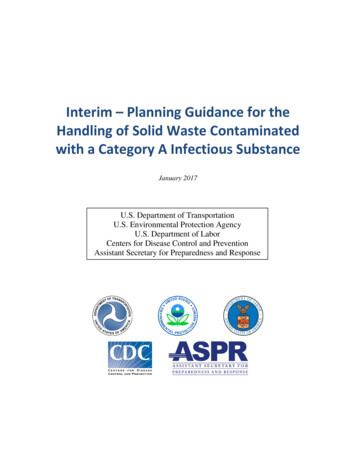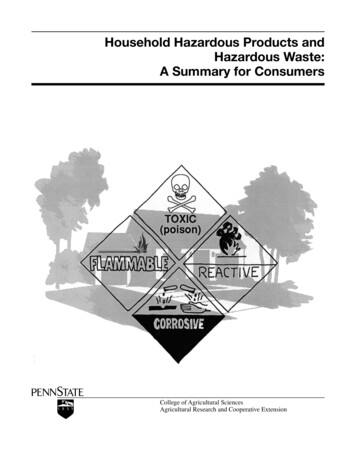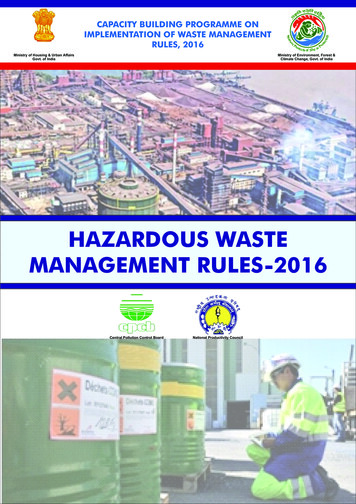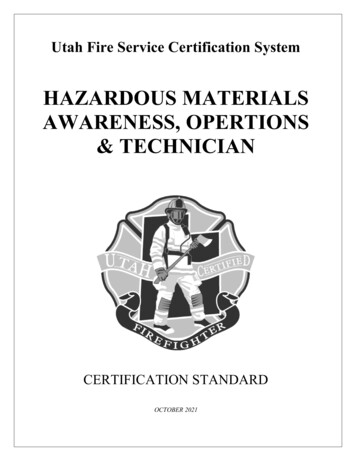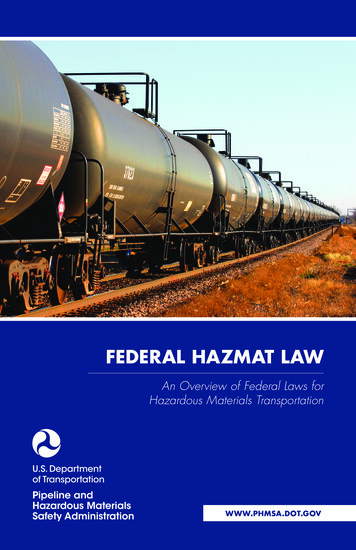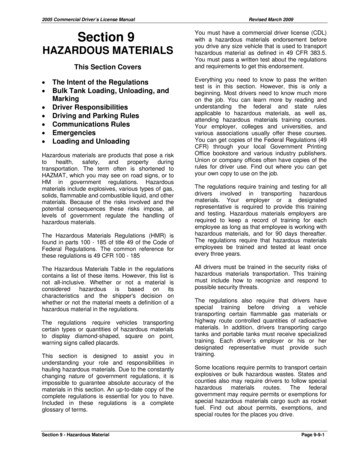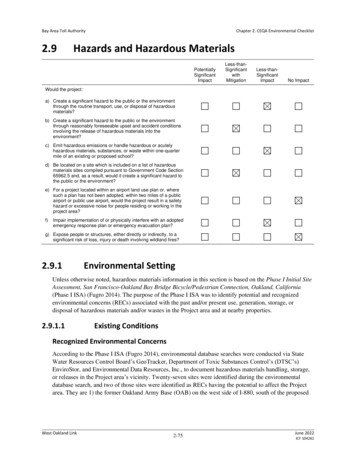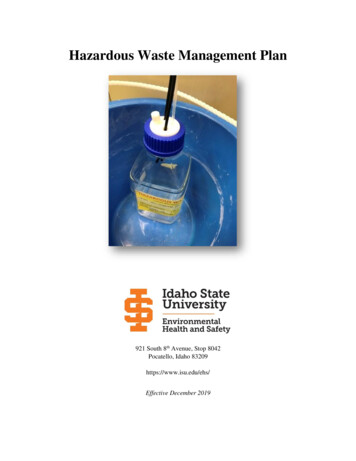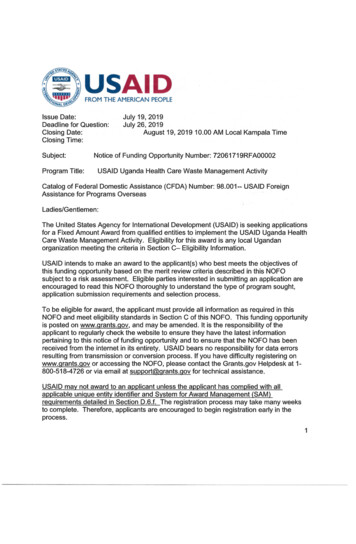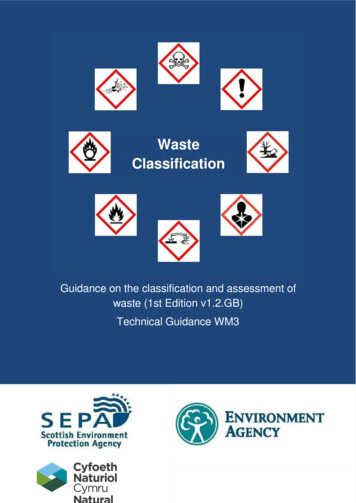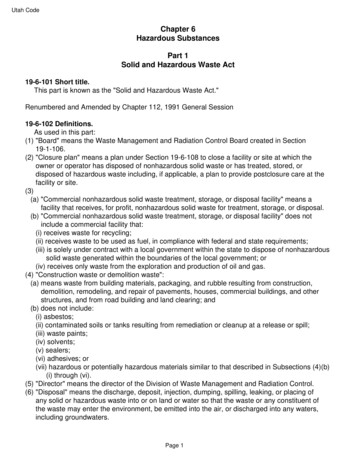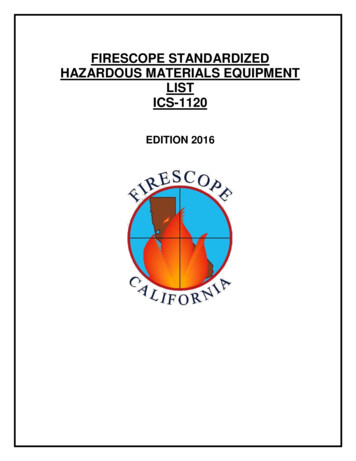
Transcription
FIRESCOPE STANDARDIZEDHAZARDOUS MATERIALS EQUIPMENTLISTICS-1120EDITION 2016
TABLE OF CONTENTSPART 1: INTRODUCTION1FORWARD .1AUTHORITY .1OBJECTIVE and PURPOSE . 1MINIMUM STATE STANDARD.2INDUSTRY STANDARDS .2INSTRUCTIONS FOR USE .3CATEGORIES: . 3INVENTORY NUMBERING: . 4ITEM NAME and DESCRIPTION: . 4CERTIFICATION or STANDARD: . 5REQUIRED and OPTIONAL ITEMS: . 6PERSONAL PROTECTIVE EQUIPMENT (PPE).6BREATHING APPARATUS PERFORMANCE CRITERIA .8UNKNOWN ENVIRONMENT: . 8CHEMICAL VAPOR/GAS: . 8CHEMICAL AEROSOL: . 8CHEMICAL LIQUID: . 8CHEMICAL PARTICULATES: . 8BIOLOGICAL AIRBORNE: . 8BIOLOGICAL LIQUID-BORNE: . 8BIOLOGICAL PARTICULATE: . 8RADIOLOGICAL PARTICULATE:. 9RADIOLOGICAL PENETRATING: . 9THERMAL or FLASH FIRE: . 9BREATHING APPARATUS TYPES .9SELF-CONTAINED BREATHING APPARATUS: . 9AIR-PURIFYING RESPIRATOR: . 9POWERED AIR-PURIFYING RESPIRATOR: . 10CHEMICAL PROTECTIVE CLOTHING . 10PROTECTIVE CLOTHING STANDARDS: . 10THREAT BASED PERFORMANCE: . 11PROTECTIVE CLOTHING TERMS: . 12SELF-EVALUATION FORMS . 12APPENDIX A – EQUIPMENT SELF-EVALUATION . 12APPENDIX B – TRAINING RECORDS SELF-EVALUATION . 12PART 2: LIST OF EQUIPMENT 141.FIELD TESTING and DETECTION . 141.11.21.31.41.5Color Change Analysis - Non-Electronic [Sub-Category] . 14Qualitative Analysis, Kits - Non-Electronic [Sub-Category] . 15Qualitative Analysis, Kits - Electronic [Sub-Category] . 16Colorimetric Analysis - Non-Electronic [Sub-Category] . 17WMD Biological Detection - Electronic . 17
2.AIR MONITORING . 182.12.22.32.4Confined Space Monitoring [Sub-Category] . 18Multiple Gas Monitoring, Toxic [Sub-Category] . 19Specialty Gas Capability [Sub-Category] . 19WMD Chemical Dedicated Instruments [Sub-Category] . 203.13.23.33.4Substance Capture [Sub-Category] . 21Bulk Liquid Transfer – Mechanical [Sub-Category] . 22Containerization, Labeling, Documentation [Sub-Category] . 23Transportation [Sub-Category] . 243.SAMPLING . 204.RADIATION MONITORING/DETECTION. 254.14.24.35.Gamma, Beta, and Alpha Detection and Survey [Sub-Category] . 25Radionuclide Detection [Sub-Category] . 26Dosimeters [Sub-Category] . 26CHEMICAL PROTECTIVE CLOTHING . 265.15.25.3Vapor Protective [Sub-Category] . 26Liquid Splash Protective [Sub-Category] . 27Limited Use Protective [Sub-Category]. 286.16.26.36.4Hand Protection [Sub-Category] . 28Foot Protection [Sub-Category] . 29Head and Eye Protection [Sub-Category] . 30Support Systems [Sub-Category] . 306.ANCILLARY PROTECTIVE EQUIPMENT . 287.TECHNICAL REFERENCE . 317.17.27.37.4Printed References, Industrial and WMD Chemicals [Sub-Category] . 31Electronic References, Industrial and WMD Chemicals [Sub-Category]. 31Plume Air Modeling, Program Support [Sub-category]. 32Computer, Support Hardware, Software [Sub-Category] . 328.18.2Advanced Technologies; Vision, Heat, Sound [Sub-Category]. 34Advanced Technologies; Weather, GPS [Sub-Category]. 359.19.29.3Chemical Intervention [Sub-Category] . 36Environmental Intervention [Sub-Category] . 37Mechanical Intervention [Sub-Category] . 388.SPECIAL CAPABILITIES . 349.INTERVENTION . 13.213.3DECONTAMINATION . 41Ground Protection [Sub-Category]. 41Support Tools for Decontamination [Sub-Category] . 42Water Supply, Distribution Tools [Sub-Category] . 43Collection [Sub-Category] . 43COMMUNICATIONS . 44Radio [Sub-Category] . 44Cellular Phone [Sub-Category] . 45RESPIRATORY PROTECTION . 45Self-Contained [Sub-Category] . 46Air Purifying Respirator [Sub-Category] . 46TOOLS / OTHER . 47General Purpose, Hand Tools, Large [Sub-Category] . 47General Purpose, Hand Tools, Small [Sub-Category] . 48Special Purpose Hand Tools [Sub-Category] . 50
PART 3: APPENDIX SECTION 53APPENDIX A . 54Self-Evaluation Form – Equipment, Tools, Kits . 54APPENDIX B . 70Self-Evaluation Form – Training Records . 70APPENDIX C . 73WMD Chemical Survey Instruments . 73APPENDIX D . 75Printed and Electronic Reference Materials . 75APPENDIX E . 79Listing of Standards Agencies . 79APPENDIX F . 81Hazardous Materials Company Types and Minimum Standards . 81APPENDIX G . 83Hazardous Materials Company Types Explanation of Components . 83
TABLES AND CHARTSTable 1: Example Types of Standards and Influence . 2Table 2: Categories and sub-Categories of the SEL . 3Table 3: Inventory Number Explanation . 4Table 4: Example of Inventory Name and Description . 4Table 5: Examples of Company Type and Items Required, and Explanation. 5Table 6: Display of Standard or Certification Requirement for Selected Items . 6Table 7: Breathing Apparatus Standards Associated with Performance Criteria . 7Table 8: Example of NIOSH CBRN label that must be affixed to the SCBA frame. . 9Table 9: Example of NIOSH CBRN label that must be affixed to the APR canister. . Error! Bookmark not defined.Table 10: Chemical Protective Clothing Standards Associated with Example Performance Criteria . 11CHART #1: WMD Chemical Survey / Monitoring Instruments and Agents Detected. . 73CHART # 2: List of Printed Database Technical References. 75CHART # 3: List of Printed Guidebook Type References . 75CHART # 4: List of Printed Specialty References . 76CHART # 5: List of Printed or Electronic Regulatory References . 76CHART # 6: List of Printed WMD Chemical / Biological References . 76CHART # 7: List of Electronic Database Software References . 77CHART # 8: List of Electronic Guidebook Software References . 77CHART # 9: List of Electronic Specialty Software References . 77CHART # 10: List of Electronic WMD Software References . 78CHART #11: Agencies, Standards, and Focus of Standards as cited or referenced within this SEL . 79
FIRESCOPE STANDARDIZEDHAZARDOUS MATERIALS EQUIPMENT LISTPART 1: INTRODUCTIONFORWARDThis California FIRESCOPE Standardized Equipment List (SEL) is provided for the purpose of being used as atool by the emergency response community in California. First responders should review this StandardizedEquipment List (SEL) when preparing to develop equipment specifications, purchase orders, creating or updatinglocal master hazardous materials equipment inventory lists, and for reviewing requirements for hazardousmaterials / WMD chemical-biological response equipment grants.FIRESCOPE, the California Office of Emergency Services, the Fire & Rescue Branch of OES, and the authors ofthis SEL do not assume liability for the performance of any equipment item mentioned in the SEL. Nor is anyapproval or endorsement of a specific equipment item or tool to be assumed by mention of a model number, brandname, or manufacturer as provided in example notations. These example notations are included in the main bodyof the equipment list for clarification and comparison purposes only. However, this SEL will describe a minimumlevel of performance for each equipment item or tool category, in an attempt to establish a minimum level ofstandardization. The user of this document is solely responsible for the specific selection and purchase of itemsto be added to their agency’s inventory. Therefore, this SEL is a reference document only, and should be usedas a guide in an attempt to meet the minimum level of standardization.AUTHORITYThis SEL is a publication of California FIRESCOPE. This edition of the SEL becomes effective upon the date ofpublication, and remains in effect until superseded by the publication of the next updated edition.OBJECTIVE and PURPOSEThe overall objective of this SEL is intended to establish a California State standard reference document, and topromote better interoperability and standardization between all Hazardous Materials Companies in the State ofCalifornia. Adoption and implementation of this SEL by emergency response agencies will insure increasedefficiency and incident intervention in the course of hazardous materials response company mutual aid.The purpose of this SEL is to:a.Provide and establish a uniform hazardous materials equipment list:Establish an all-encompassing list of equipment that has been found to be consistent with and oftenutilized by hazardous materials response teams. The listing of equipment items included in this list ispredicated upon the evolution of hazardous materials response intervention, and the history ofpopularity, utility, and need as demonstrated by the maintenance of local agency inventories. Thismaster list would serve as the basis for a sourcing document.b.Establish standardized equipment and tool response categories and criteria:Create a standardized set of “Categories” and “Sub-Categories”. Equipment will be listed within thesecategories and sub-categories based upon their function. The function shall be described in a criteriaparagraph that will accompany each category and sub-category.c.Adopt standardized equipment and tool performance descriptions:Each individual equipment item shall be briefly described in terms of a short use or performancestatement. In many cases the description will also include example sizes or approximate dimensions.1
d.Support Hazardous Materials Company Typing equipment needs:Consistent with the FIRESCOPE Field Operations Guide (ICS 420-1), Hazardous Materials CompanyTypes and Minimum Standards chart, this list will identify and establish the minimum thresholdequipment items needed to meet any one of the three types of hazardous materials companies. Thislist would also identify other hazardous materials equipment items that could be considered to beincluded in a local agency’s inventory.e.Promote use and adherence to industry accepted performance standards:This list, where appropriate, shall identify various performance and regulatory standards to which theuser (agency having jurisdiction, i.e. the employer and the employee) must comply, as well as thosestandards that provide a minimum level of performance of the item, tool, or piece of equipment (i.e. themanufacturer).MINIMUM STATE STANDARDThe development and adoption of the SEL shall represent the establishment of a recognized state standard. Itshall further represent a minimum recommended inventory for each of the three Types of hazardous materialscompanies (Haz-Mat Type 1, Haz-Mat Type 2, Haz-Mat Type 3) as described in Appendix F, “HazardousMaterials Company Types and Minimum Standards, and in the FIRESCOPE Field Operations Guide.Items noted as being required for each of the three hazardous materials company types represents a minimumequipment standard. Local jurisdictions may in many instances elect to exceed this minimum equipment standard.To further insure and encourage attempts at uniformity and standardization, additional equipment items are listedin this SEL which are not required, and are noted as being optional. See REQUIRED and OPTIONAL ITEMSsection of this SEL for further explanation.Local jurisdictions may also elect to include specialized equipment not listed in this SEL.INDUSTRY STANDARDSWhere-ever possible, the selection, purchase and use of equipment items and tools in support of response toincidents involving toxic andType ardweapons of mass destruction Cal/OSHA, Fed/OSHA / NIOSH:Safety lOccupational Safety and Healthworking conditionssubstances (WMD Chem-Bio)Safety equipment, tools,PerformanceConsensusshould be done so in compliance NFPA:National Fire Protection Associationprotective clothingwith nationally recognized andaccepted standards and protocols. ASTM:Materials testing, toolVarious agencies develop andpublish performance standards,protocols, and approval listings inan attempt to establish a minimumacceptable performance thresholdfor a particular item, tool, garment,or instrument. Table 1 illustratesa few examples of these agencieswho publish standards, protocolsand listings, and notes their types.American Society for the Testing ofMaterialsPerformanceConsensusTesting proceduresPerformanceConsensusEPAEnvironmental Protection AgencyCleanliness protocols, nonpolluting protocolsPerformanceMandatoryIEEE:Institute of Electrical and ElectronicsEngineersElectronic instruments; andTelecommunicationsPerformanceConsensusTool, appliance, instrumentdesign and erican National StandardsInstituteUL:Underwriter’s LaboratorySome standards and protocols areregulatory in nature, in that they Table 1: Example Types of Standards and Influencebecomemandatoryforimplementation by the employer. These standards focus on working conditions, work process procedures, safety2
procedures, training documentation, and provision of safety gear. Most federal agencies (i.e. OSHA, EPA, DOE,DOT, etc.) and many state agencies (i.e. Cal/EPA, Cal/OSHA, Dept of Health Services, etc.) issue regulatorystandards. Consensus standards, such as performance standards, are developed to promote minimum thresholdlevels of performance of items or tools, and “consensus” means the adoption of the standard by a local entity isvoluntary. However, once adopted, the standard becomes mandatory. Non-profit service organizations (i.e.NFPA, ASTM, ANSI, UL, FM) issue consensus standards and consensus listings. Some consensus standards(i.e. NFPA) also establish a set of minimum performance tests to which an item, tool, garment or instrument mustbe subjected to, and must pass, in order to be certified compliant to that standard. Items that have been submittedand pass this testing and certification regimen provide for the end user the following assurances: Highest and/or most broad spectrum of performanceHighest level of safetyDemonstrated durabilityConsistency of performance over timeConsistency of manufactureConsistency of good formancestandards(consensus), and other influencing edictssuchasapplicablecertificationrequirements, and testing listing shall beincorporated into this SEL whereappropriate. Adherence to regulation,standards, certification requirements,testing, and product listing providesassurance of a minimum level ofacceptable safety. In order to qualify as aFIRESCOPE Type 1, Type 2, or Type 3hazardous materials company, theequipment inventory of each type ofcompany must meet this SEL as aminimum.Cat.#This Standardized Equipment List isdivided into thirteen (13) main equipmentcategories, as noted in Table 2. Thesemain categories constitute the template forthe Master Table of Contents. Thesecategories also correlate with theComponents column in the FIRESCOPE“Hazardous Materials Company Typesand Minimum Standards”, chart as foundin Appendix F.Each main category may be furtherdivided into one or more sub-categories.Each category (i.e. Chemical ProtectiveClothing) and each individual subcategory (i.e. Vapor Protective) includes adescriptive paragraph that explains anddefines in more detail the specific criteriathat encompasses that category and subcategory.Includes Sub-Categories1Field Testing andDetection Color Change Analysis - Non-ElectronicQualitative Analysis, Kits - Non-ElectronicQualitative Analysis, Kits – ElectronicColorimetric Analysis - Non-ElectronicWMD Biological Detection - Electronic2Air Monitoring /Survey Confined Space MonitoringMultiple Gas Monitoring, ToxicSpecialty Gas CapabilityWMD Chemical Detection Capability3Sampling Substance CaptureBulk Liquid Transfer - MechanicalContainerization, Labeling, DocumentationTransportation4RadiationMonitoring andDetection Gamma, Beta, Alpha Detection and Survey Radionuclide Detection Dosimeters5ChemicalProtectiveClothing Vapor Protective Liquid Splash Protective Limited Use Protective6AncillaryProtectiveEquipment Hand ProtectionFoot ProtectionHead and Eye ProtectionSupport Systems7TechnicalReferences Printed References, Industrial & WMD ChemicalsElectronic References, Industrial & WMD ChemicalsPlume Air Monitoring, Program SupportComputer, Support Hardware and Software8SpecialCapabilities Advanced Technologies; Vision, Heat, Sound Advanced Technologies; Weather, GPS9Intervention Chemical Intervention Environmental Intervention Mechanical Intervention10Decontamination 11Communications Radio Cellular Phone12RespiratoryProtections Self-Contained Air Purifying13Tools / Other General Purpose, Hand Tools - Large General Purpose, Hand Tools - Small Special Purpose ToolsINSTRUCTIONS FOR USECATEGORIES:Main CategoryGround ProtectionSupport Tools for DecontaminationWater Supply, Distribution ToolsCollectionTable 2: Categories and sub-Categories of the SEL3
The itemized listing of all equipment or tools are found immediately following a sub-category.INVENTORY NUMBERING:The listing of all appropriate individual items, tools, and equipment that follows a sub-category are given a specificand unique number. This is indicated in a column named “Inv. #.” This number will become the unique assignedinventory number for that item within this SEL. It should be noticed that the number relates to its category and toits sub-category. Therefore, by referencing a specific tool or item’s SEL inventory number, it will be easy todetermine what category and what sub-category that tool or item falls under.PART TWO of this SEL is an all-inclusive listing all equipment items, including “optional” items, where it will benoted that inventory numbers are consecutive with no intervening numbers skipped or left out. Appendix A inPART 3, FIRESCOPE Type 1, Type 2, & Type 3 Hazardous Materials Resource Self-Evaluation Form –Equipment, Tools, Kits, is provided so that an agency can conduct a self-evaluation in anticipation and preparationfor a hazardous materials resource typing inspection. This one form can be used for any one of the threeinspection types. It will be noted in this Self-Evaluation Form that some inventory numbers do skip. This is theresult of removing all items that are optional (Opt) as noted in PART 2 of the S.E.L.The inventory number format i
local master hazardous materials equipment inventory lists, and for reviewing requirements for hazardous materials / WMD chemical-biological response equipment grants. FIRESCOPE, the California Office of Emergency Services, the Fire & Rescue Branch of OES, and the authors of
